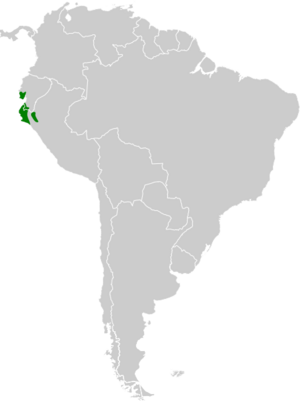West Peruvian screech owl facts for kids
Quick facts for kids West Peruvian screech owl |
|
|---|---|
| Conservation status | |
| Scientific classification | |
| Genus: |
Megascops
|
| Species: |
roboratus
|
 |
|
| Synonyms | |
|
Otus roboratus Bangs & Noble, 1918 |
|
The West Peruvian screech owl (Megascops roboratus) is a small owl that lives in Ecuador and Peru. It belongs to the Strigidae family, which includes many types of owls. This owl is known for its unique calls, which help scientists tell it apart from other similar owls.
Contents
How Scientists Classify This Owl
Scientists use a system called taxonomy to classify living things. The West Peruvian screech owl was once thought to be the same species as the tropical screech owl. However, their different calls showed that they are actually separate species.
There are two main types, or subspecies, of the West Peruvian screech owl:
- M. r. roboratus (the main type)
- M. r. pacificus
Some experts even think M. r. pacificus might be a completely separate species on its own!
What Does This Owl Look Like?
The main type of West Peruvian screech owl (M. r. roboratus) is about 20 to 22 centimeters (8 to 9 inches) long. It weighs around 144 to 162 grams (5 to 6 ounces).
These owls can come in two different color forms, called "morphs":
- Gray morph: This owl has a grayish face with a black border. It has white "eyebrows" above its pale to golden yellow eyes. It also has small ear tufts on its head. Its upper body is grayish-brown with faint darker stripes. It has a light collar on the back of its neck. Its belly is whitish with faint wavy lines.
- Rufous morph: This owl is reddish-brown all over with dark brown markings.
The M. r. pacificus subspecies is smaller and lighter. It is about 18 to 19 centimeters (7 to 7.5 inches) long and weighs 70 to 90 grams (2.5 to 3 ounces). Its gray morph is usually grayer than the main type. Its reddish-brown (rufous) morph is also more common.
Where Does This Owl Live?
The M. r. pacificus subspecies lives in southwestern Ecuador, in areas like Santa Elena and Guayas Province. It also lives a little bit into northwestern Peru, as far south as Lambayeque Province.
The main type, M. r. roboratus, lives more inland. It can be found in the river valleys of the Río Chinchipe and Río Marañón. These rivers are located between the western and central Andes mountains.
Owl Homes and Habitats
The M. r. roboratus owl prefers dry forests with trees that lose their leaves. It lives on mountain slopes and hills. It usually lives at heights between 500 and 1,200 meters (1,600 to 3,900 feet). Sometimes, it can be found as high as 1,800 meters (5,900 feet) in Ecuador and 2,100 meters (6,900 feet) in Peru.
The M. r. pacificus owl lives in dry coastal areas. It likes scrublands and forests where trees lose their leaves. It generally lives closer to sea level, up to about 500 meters (1,600 feet) high.
Owl Behavior
What Do They Eat?
The West Peruvian screech owl is a nocturnal animal, meaning it is active only at night. As far as we know, its diet is mostly, and possibly only, insects. It hunts for its food in the darkness.
Life Cycle and Reproduction
Both types of West Peruvian screech owls have been seen nesting in holes found in trees. The main type (M. r. roboratus) might also use old nests built by another bird called the Pale-legged Hornero. Not much else is known about how these owls raise their young.
What Do They Sound Like?
The song of the main West Peruvian screech owl (M. r. roboratus) is a series of equally spaced notes. These notes get louder towards the end, like a trill.
The song of M. r. pacificus is similar. It is also a trill that gets louder. However, it drops slightly in pitch towards the end.
Status of the Owl
The IUCN (International Union for Conservation of Nature) has listed the West Peruvian screech owl as a species of "Least Concern." This means it is not currently considered to be in danger of disappearing.
However, this owl is generally rare. It might even be vulnerable in some areas. A lot of its natural home has been damaged by animals grazing and by people cutting down trees for wood. Protecting these habitats is important for the owl's future.


